2011: ONE GREAT YEAR
In 2027, the University of Houston will celebrate its 100th birthday. A history of the university will be written that year – a chronicle of the University’s growth and successes through the decades.
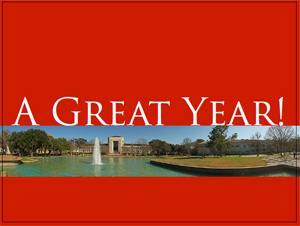
Without a doubt, there will be a chapter dedicated to one particular year – 2011 –
the year when the University of Houston planted its red-and-white banner on the national
academic scene.
We have always been nationally recognized for individual programs, whether creative writing, or chemical engineering, or hotel and restaurant management, or social work.
It was in January of this year that, for the first time, we received the top recognition for the university as a whole from the Carnegie Foundation for the Advancement of Teaching. This recognition made us the 3rd nationally competitive tier one public research university in the state of Texas.
Let me remind you that there are some 4,800 colleges and universities in the United States. Only 108 are placed in this top tier list. Congratulations! We did it!
Just two months after Carnegie, we received another spectacular endorsement – this time from the Princeton Review – when it added the University of Houston to its list of 376 "Best Colleges in America." This ranking is based on student surveys, which proves that our students know they are getting one of the best educational experiences anywhere and they are not shy about letting everyone know
Fast forward to May, when we received more good news – this time from the Top American Research Universities (TARU). This ranking measures the level of research strength and productivity in universities, and the University of Houston made the top 50 list on 3 measures! If it sounds easy, consider this – only 57 public universities have 3 or more qualifying measures on the TARU list – quite an accomplishment!
Yet another national recognition came in July, from The Chronicle of Higher Education, when they declared that the University of Houston is one of the nation’s "Great Colleges to Work For"…
The University of Houston now joins 54 universities nationwide on this prestigious list. We received recognition for our diversity, collaborative governance, teaching environment, and respect and appreciation.
The purpose of my address today is to measure our progress, celebrate our achievements, outline our challenges, and reaffirm our goals. There is no better tool to do so than the Progress Card that our Board of Regents approved 3 years ago as a measure of self-assessment and public accountability.
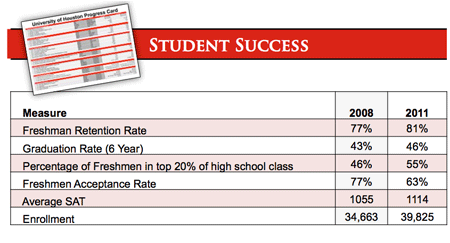
Student Access and Success is the most critical area of performance, and we continue to make huge strides. This year:
- The enrollment is 39,825, an all-time high!
- The freshmen average SAT is 1114, an all-time high!
- The Honors College has the largest class ever, with the average freshmen SAT of 1303, an all-time high!
- 31% of freshmen rank in the top 10% of their high school class... and 55% rank in the top 20%. Again, an all-time high!
- 46 National Merit Scholars and 80 Tier One scholars are among our students.
- 81% of the freshmen returned as sophomores, an all-time high!
- Nearly $200 million have been distributed to students as financial aid, more help than ever!
- And finally, students are more proud to be Cougars than ever… at least that is what those loud pep rallies tell us.
I hope you agree that our Office of Admissions and the Orientation Staff have done an outstanding job in raising the bar.
As important as student access is, there is something even more important, and that is student success. Yes, we have more students than ever! And yes, we are graduating more students than ever! But, are we graduating them on time, with as small a debt burden as possible, and with the skills that will make them leaders in the world?
Two years ago, we started to work on a 9-point plan to enhance the 6-year graduation rate.
One of the initiatives was to "create a residential environment on campus" and we have made tremendous progress in this area.
We look forward to the leadership of our new Vice President for Student Affairs, Dr. Richard Walker, to help create a tier-one living and learning environment.
Today, we have 6,000 beds on campus, and the Board of Regents have approved an additional bed capacity of 2,000, bringing our total to 8,000 by 2013. Today, we are the 4th largest public residential university in Texas and with the additional capacity, we will surpass every school but one.
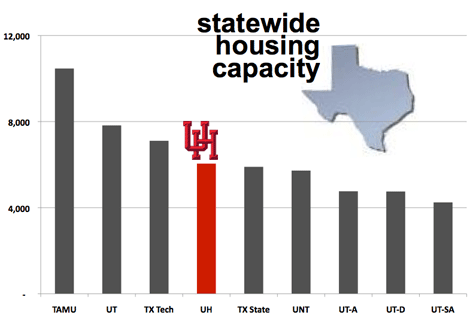
But, campus housing is not just a place to rest your head – it is about bonding, learning and graduating! Just a few weeks ago, we welcomed members of the Class of 2015. Hundreds of students, faculty, and staff volunteers, calling themselves "Cougar Movers," came out in 100-degree heat to unload boxes, direct traffic, and help students get settled. This is what I call the culture of student success! Thank you, Cougar Movers!
Another initiative was to have "exciting and relevant educational programs." Our Petroleum Engineering is one of many programs that speak of relevancy and excitement. Started in 2009 with 20 students, the program has grown to 224 students, has received $11.5 million from industry and another $1 million from private supporters. It is gaining national recognition for its curriculum, which by the way, was designed by the faculty and industry together.
Similarly, our partnership with Texas Medical Center institutions has added new training opportunities for students in health sciences. A dual degree program with the University of Texas-Houston School of Nursing is one such program, where 25% of the seats in each entering nursing class are reserved for UH students. A similar program with a medical school is also in the works.
Yet another initiative was to align the admissions standards at the University of Houston. Our admissions standards will change next year, and then again in 2014, making the University of Houston consistent with other tier one universities across the state and the nation.
You may ask, will this limit access to UH? Will this adversely impact our commitment to closing the education gap in the state?
Research indicates that higher expectations inspire people to work harder and achieve greater, as long as they have the tools to do so. The focus has to be on offering the necessary tools, not on diluting expectations, because as we all know, our graduates will face a world that is globally competitive, a world that will accept no excuses.
Keeping students and their success at heart, we have expanded our toolkit. To guide students, we have placed our advisors in community colleges. To reduce cost and time to earn a degree, we have identified courses that offer college credits to high school students. To ensure that money is not an issue, we are offering free education to students from low-income families.
The result is that we are the second most diverse research university in the nation, and we rank #12 in the nation for graduating students with the least amount of debt.
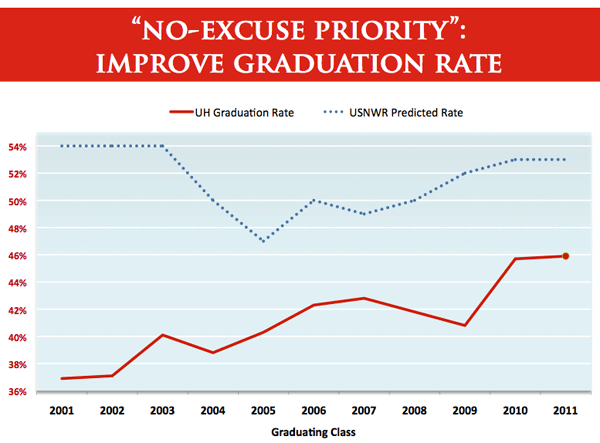
Our 9-point plan has put us on the right track. Retention and graduation rates have increased. But they still lag behind the national and state averages. According to the US News & World Report and based on our freshmen profile, our graduation rate should be 53%, but it is only 46%.
This 7% gap is sufficient to keep us from getting into the Tier One US News & World Report ranking. And let’s be honest, this 7% gap is not because of who we admit, but because of what happens to them after we admit them. If we want to be credible as a tier one university, we must increase our graduation rate to 53% as soon as possible.
With proper attention, we can achieve our goal of student success. We have done it in athletics.
- This spring, our student athletes had the highest GPA ever recorded in the history of UH.
- They passed 13.7 credit hours per semester, again a record-breaker!
- Their federal graduation rate is 52%, higher than ever!
- And they are doing it while excelling on the field… winning conference championships, and regional and national titles. And yes, being 5-0 in Football!
- It is interesting to note that our athletics program was ranked #6 in the nation for best integration of academic best practices in athletics by the Coalition on Intercollegiate Athletics.
I would like to recognize Maria Peden and the Student -Athlete Academic Services staff for their outstanding work.
Going forward, I ask that student success, particularly increasing the graduation rate, continue to be our "no-excuse priority." We must continue to focus on student success inside and outside the classroom and we must do so whole-heartedly.
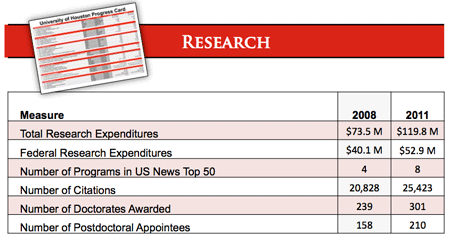
Now, as we turn to "research and discovery," which is another area of performance in our Progress Card, I would like to welcome our new leader, Vice President for Research and Technology Transfer, Dr. Rathindra Bose.
In research, I have 3 news items to share – the great one… the promising one… and the surprising one.
The great news is that we are not just a Carnegie-ranked Tier One university, but that we are comfortably in that group!
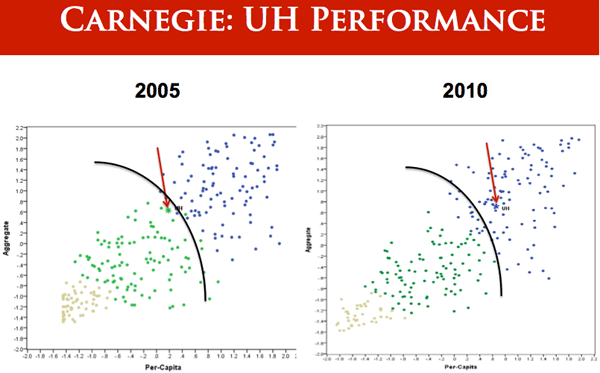
The slide shows two charts depicting our placement on the Carnegie classification in 2005 and 2010. Universities with blue dots are Tier One universities, and you can see the University of Houston’s move in 5 years. We must keep and increase our lead in this group in preparation for the next round of re-classifications by Carnegie.
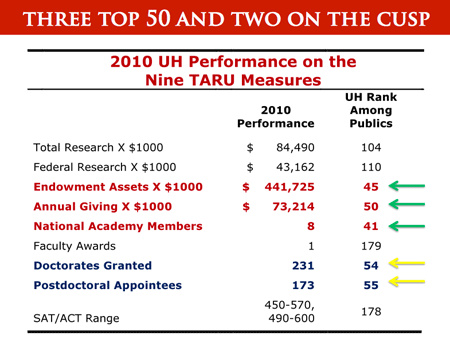
The promising news is that we did equally well in the report published by the Top American Research Universities or TARU. Each year, TARU publishes a list of universities, ranked in the t op 25 and the top 50. The University of Houston made the Top 50 list for having placed 3 of the 9 required measures in the top 50 among public universities nationwide! Two additional measures are at the cusp of breaking the Top 50 threshold!
Ten years ago, the University of Houston ranked on the Top 50 list for having placed 3 of the 9 measures, just as it did this year. However, in 2008, TARU raised its minimum qualifying bar, and the University of Houston fell from the list. In 2009, we got back on the list with 1 measure in the top 50. Last year, we continued our progress by placing 3 measures in the top 50!
Going forward, our goal is to place 5 of the 9 measures in the Top 50, with at least 1 of them in the top 25! That will give us the sustained excellence that we seek.
This year, we lost a valued faculty member, Dr. Neil Amundson, who was a member of 2 National Academies. Replacing such a talent is never possible, but to build on his legacy, we added 3 new members of the National Academies to our roster.
Dr. John Lee, the world’s foremost petroleum engineer, joined us from Texas A&M. Professor Joseph Colaco, one of the leading structural engineers of the century, teaches in the Gerald D. Hines College of Architecture.
Finally, Dr. Benton Baugh, an accomplished engineer in Houston, has chosen to affiliate himself with a winner, the University of Houston, his alma mater.
Many of our faculty received national honors and recognitions this year. Let me point out two as examples.
Professor Rebecca Lee received a Fulbright Fellowship to Mexico and, as expected, she is currently in Mexico.
Dr. Vassiliy Lubchenko received a Sloan Research Fellowship. Just this award will be an admirable act in itself, but consider the fact that this is his third national award in 3 years! What a tremendous role model for all of us!
Now, the surprising news in research comes from the least talked about area – technology transfer. It is good to make a new discovery…it is better to put that discovery into use…but it is best when that discovery starts to bring revenue that helps fund new discoveries.
The University of Houston has become a leader in the state and the nation for licensing revenue.
In 2008 the University of Houston received $1.1 million in royalty and licensing income. This amount increased to approximately $9 million in 2011. Five researchers are responsible for most of this revenue – Professors Howard Kohn and Diana Chow from the College of Pharmacy, Professors Paul Chu and Alex Freundlich from NSM, and Professor Venkat Selvamanickam from the Cullen College of Engineering.
Of course their technologies were licensed many years ago. Nonetheless, they inspire us to aggressively license new technologies and take them to the marketplace. Going forward, this will be an area of priority for the university.
Our faculty are working harder than ever! They wrote $423 million worth of proposals to federal agencies last year, which is a 15% increase in one year. Our federal research expenditures also increased, by 4%, to $64 million, which gives the University of Houston its highest expenditure figure.
As wonderful as it is to brag about research grants and IP revenue, it is even more important to remember that not all wonderful research is quantifiable in numbers. Our professors in the humanities, the social sciences, and the professional disciplines engage in cutting-edge research that advances the boundaries of knowledge each day. Their impact is felt, not counted.
As an example, think how meaningful medicine could be if we could understand the different ways in which ethnic communities respond to diseases and their treatment? Dr. Barbara Evans, a nationally known faculty member in the UH Law Center, and Dr. Jarron Saint Onge in the Department of Sociology, study health disparity and health behavior patterns. Without their work, millions of dollars spent on discovering drugs cannot serve the people that they must.
Lastly, quality graduate and specialty programs are critical to any research university. And, we have a good number of them winning national rankings. Our Law Center has distinguished itself by placing 3 of its programs in the top 10 nationally.
Before I leave this subject, let me congratulate our undergraduate entrepreneurship program for having ranked #1 in the nation, second year in a row.
The University of Houston is the only university in the UH System to offer doctoral programs. These programs allow us to prepare educators of tomorrow and we take this responsibility seriously. With the help of Houston Endowment’s $5 million grant, our goal is to provide better support to these students, and increase the annual number of Ph.D.s awarded by 50%, from 200 to 300
Going forward, we will continue to strengthen our research capacity and graduate training. This will require strategic investments, but it will also require changing the institutional culture to one that is accountable and supportive of true excellence.
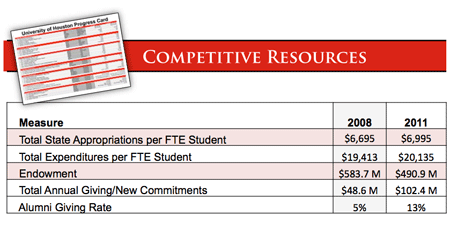
This brings us to the issue of resources. We all know that public universities faced a very rough legislative session this year. Our general revenue appropriation from the state was slashed by almost $70 million! And even though tuition was increased, it was not enough to make up for the reduction.
We balanced the budget by creating operational efficiencies, generating additional revenues, reducing the workforce and freezing faculty/staff raises. Consequently, our per-credit-hour production cost reduced by 5%.
Unfortunately, budget difficulties are not over. Even the most optimistic predict that the state budget will see another serious shortfall in 2013. Our "student success" and "tier one" goals are non-negotiable, so the only way to succeed in the future is to embrace a new business model – a model that awards performance, promotes excellence, encourages innovation, and diversifies revenue.
At this time when we have great momentum, we cannot afford to let our talent leave for greener pastures, either nationally or internationally. Therefore, this year, I am committed to faculty/staff raises based on strict evaluation and meritorious performance.
We will continue to make focused investment in research. Thanks to your effort and the support of our legislative delegation, we have current and new state funding of more than $40 million for the new biennium geared solely toward research. We will use these funds wisely and strategically to strengthen our research capacity.
In these times of uncertain state support, private giving is critical to maintaining our momentum. This year, we raised $75 million, and if you add $30-million of committed but un-booked donations toward the Football Stadium, we surpassed the $100 million mark.
Going forward, the goal is to build a sustainable annual fund-raising portfolio of $100 million, and in order to do so, we will need a robust, organized group of volunteers. Creating such a network in preparation for launching a capital campaign is a priority.
The good news is that our alumni are getting increasingly engaged. They are happy, they are proud, they are showing off their colors, and they are coming back to build their alma mater. This year, 18,000 alumni contributed $8.4 million to the university, a number that is larger than ever in our history.
As if in competition with alumni, our staff also made this last year a record-breaking year. Together they donated with passion and surpassed their own goal. And what about students and their generosity? They are blazing a new trail, too. Over 15% of our May 2011 graduates made a gift to the university at their graduation!
Diversifying revenue is critical and we are looking at every possible avenue to leverage our strength.
A good example is our robust construction program. Taking advantage of low construction cost and good credit market, we are building tier one facilities for students and faculty.
Since 2008, $219 million worth of projects have been completed. Another $219 million are currently underway. An additional $200 million are in the design and financing phase. The ongoing and coming projects include:
- Classroom and Business Building
- Stadium Garage
- Health and Biomedical Sciences Center
- Science Teaching Laboratory building
- SERC additional build out
- Cougar Village II
- Cougar Place
- West side Dining Facility
- Blaffer Museum renovation
- UC renovation and expansion,
- Multi-Modal Garage 1
- And, of course, the Football Stadium
No state funding, unless specifically designated for construction, is being used for any of these projects.
Despite challenges, I remain optimistic for the future of the University of Houston, because our momentum is strong and our assets are tremendous
The city of Houston is a great asset and resource to us, a city with the 4th largest population center in the United States, a city that is diverse and innovative, a city that is the energy capital of the world, a city that is home to the world’s largest medical center, a city that has a unique "can do" spirit, a city that believes in the University of Houston.
Of course, the great state of Texas is another asset. Texas is a state that wants to close the education gap, but that also recognizes the value of global competitiveness and, therefore, has funded the Tier One initiative.
The greatest asset, however, is our people. You… our world class faculty, dedicated staff, passionate core of alumni, and our ever-energetic students. You are our most valuable assets.
Our twin goals of tier one and student success are non-negotiable. We will find creative ways to keep the momentum. We will make hard decisions and tough choices. We will make them together, but we will make them.
Today, I ask for your leadership and I ask for your energy, the energy of each and every one of you.
Why?
Imagine a train going at a top speed of 60 or 70 miles an hour. To an observer, it would seem like the engine is pulling the entire train…all of the cars…all 20 of them! But in reality, the engine is only pulling the first car. The second car is pulled by the first car, the third by the second, and so on. It is the connection that passes the energy, and pulls the next car. No matter where our engine is, we all are pulling each other in turn, and moving ahead as a team.
No matter what your role is, or what office or department you work in… you are a part of this train and without your pulling, this train cannot move. Mahatma Gandhi, whose birthday was 2 days ago, said, "A small body of spirits fired by an unquenchable faith in their mission can alter the course of history."
It is our history and we can write it!…
Thank you